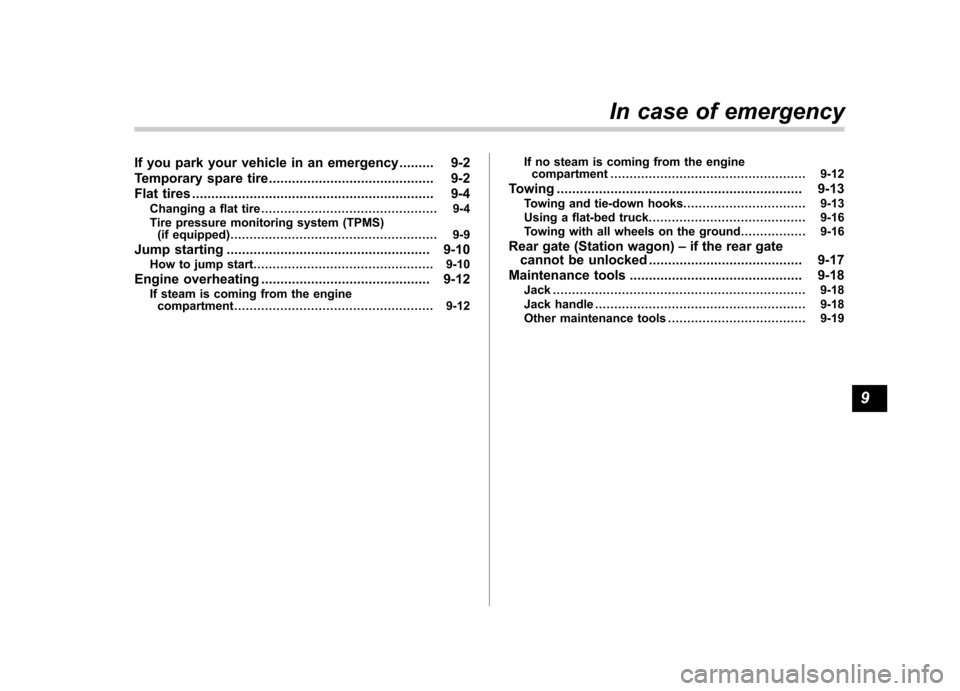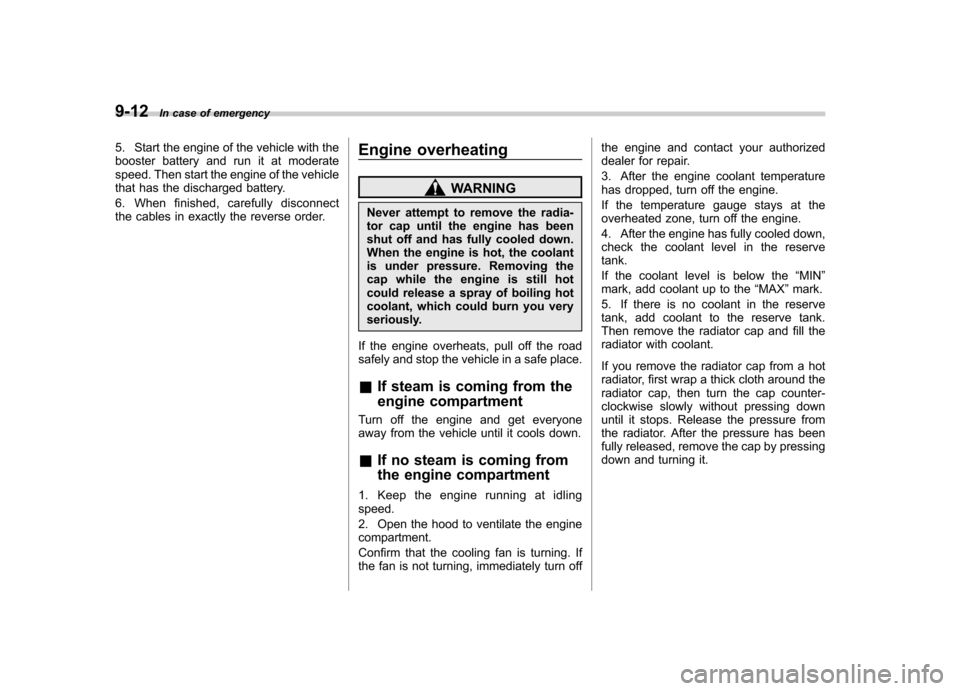2007 SUBARU OUTBACK engine overheat
[x] Cancel search: engine overheatPage 316 of 442

the trailer and have repairs performed
immediately by the nearest SUBARU
dealer. !Driving on grades
. Before going down a steep hill, slow
down and shift into lower gear (if neces-
sary, use 1st gear) in order to utilize the
engine braking effect and prevent over-
heating of your vehicle ’s brakes. Do not
make sudden downshifts. . When driving uphill in hot weather, the
air conditioner may turn off automatically
to protect the engine from overheating. . When driving uphill in hot weather, pay
attention to the water temperature gauge
pointer (for all vehicles) and AT OIL TEMP
warning light (for AT vehicles) since the
engine and transmission are relatively
prone to overheating under these condi-
tions. If the water temperature gauge
pointer approaches the OVERHEAT zone
or the AT OIL TEMP warning light illumi-
nates, immediately switch off the air
conditioner and stop the vehicle at the
nearest safe place. Refer to the “Engine
overheating ”section in chapter 9, and
“ Warning and indicator lights ”section in
chapter 3. NOTE
With AT vehicles, the temperature of engine coolant is less likely to rise to
the OVERHEAT zone in the
“D ” posi-
tion than in the manual mode position. . If your vehicle has an automatic trans-
mission, avoid using the accelerator pedal
to stay stationary on an uphill slope
instead of using the parking brake or foot
brake. That may cause the transmission
fluid to overheat. ! Parking on a grade
Always block the wheels under both
vehicle and trailer when parking. Apply
the parking brake firmly. You should not
park on a hill or slope. But if parking on a
hill or slope cannot be avoided, you
should take the following steps:
1. Apply the brakes and hold the pedal down.
2. Have someone place wheel blocks
under both the vehicle and trailer wheels.
3. When the wheel blocks are in place,
release the regular brakes slowly until the
blocks absorb the load.
4. Apply the regular brakes and then
apply the parking brake; slowly release
the regular brakes.
5. Shift into 1st or reverse gear (manual
transmission) or “P ” (automatic transmis-
sion) and shut off the engine. Driving tips
8-29
Page 318 of 442

If you park your vehicle in an emergency......... 9-2
Temporary spare tire ........................................... 9-2
Flat tires ............................................................... 9-4
Changing a flat tire .............................................. 9-4
Tire pressure monitoring system (TPMS) (if equipped) ...................................................... 9-9
Jump starting ..................................................... 9-10
How to jump start ............................................... 9-10
Engine overheating ............................................ 9-12
If steam is coming from the engine compartment .................................................... 9-12 If no steam is coming from the engine
compartment ................................................... 9-12
Towing ................................................................ 9-13
Towing and tie-down hooks. ............................... 9-13
Using a flat-bed truck. ........................................ 9-16
Towing with all wheels on the ground ................. 9-16
Rear gate (Station wagon) –if the rear gate
cannot be unlocked ........................................ 9-17
Maintenance tools ............................................. 9-18
Jack .................................................................. 9-18
Jack handle ....................................................... 9-18
Other maintenance tools .................................... 9-19
In case of emergency
9
Page 329 of 442

9-12In case of emergency
5. Start the engine of the vehicle with the
booster battery and run it at moderate
speed. Then start the engine of the vehicle
that has the discharged battery.
6. When finished, carefully disconnect
the cables in exactly the reverse order. Engine overheating
WARNING
Never attempt to remove the radia-
tor cap until the engine has been
shut off and has fully cooled down.
When the engine is hot, the coolant
is under pressure. Removing the
cap while the engine is still hot
could release a spray of boiling hot
coolant, which could burn you very
seriously.
If the engine overheats, pull off the road
safely and stop the vehicle in a safe place. & If steam is coming from the
engine compartment
Turn off the engine and get everyone
away from the vehicle until it cools down. & If no steam is coming from
the engine compartment
1. Keep the engine running at idling speed.
2. Open the hood to ventilate the engine compartment.
Confirm that the cooling fan is turning. If
the fan is not turning, immediately turn off the engine and contact your authorized
dealer for repair.
3. After the engine coolant temperature
has dropped, turn off the engine.
If the temperature gauge stays at the
overheated zone, turn off the engine.
4. After the engine has fully cooled down,
check the coolant level in the reservetank.
If the coolant level is below the
“MIN ”
mark, add coolant up to the “MAX ”mark.
5. If there is no coolant in the reserve
tank, add coolant to the reserve tank.
Then remove the radiator cap and fill the
radiator with coolant.
If you remove the radiator cap from a hot
radiator, first wrap a thick cloth around the
radiator cap, then turn the cap counter-
clockwise slowly without pressing down
until it stops. Release the pressure from
the radiator. After the pressure has been
fully released, remove the cap by pressing
down and turning it.
Page 433 of 442

14-4Index
Driving All-Wheel Drive vehicle ........................................... 3-30
Car phone/cell phone .................................................. 7
Drinking ..................................................................... 6
Drugs ........................................................................ 6
Foreign countries ..................................................... 8-4
Pets .......................................................................... 7
Snowy and icy roads ................................................ 8-9
Tips....................................... 7-16, 7-18, 7-23, 7-29, 8-5
Tired or sleepy. ........................................................... 7
E
ECO gauge ................................................................. 3-8
Electrical system ........................................................ 12-3
Electronic Brake Force Distribution (EBD) system ........................................................... 3-29, 7-36
Emergency Locking Retractor (ELR) ............................. 1-14
Engine Compartment overview ........................................... 11-6
Coolant ................................................................ 11-14
Exhaust gas (Carbon monoxide) ............................ 6, 8-2
Hood .................................................................... 11-4
Oil........................................................................ 11-9Overheating .......................................................... 9-12
Starting ................................................................... 7-9
Stopping ............................................................... 7-11
Exterior care .............................................................. 10-2
F
Flat tires ..................................................................... 9-4
Floor mat .................................................................. 6-12 Fluid level
Automatic transmission ......................................... 11-22
Brake .................................................................. 11-29
Clutch ................................................................. 11-30
Power steering ..................................................... 11-28
Fog light switch .......................................................... 3-42
Front
Differential gear oil ................................................ 11-24
Fog light .............................................................. 11-53
Seatbelt pretensioners ............................................ 1-24
Seats ..................................................................... 1-2
Turn signal light .................................................... 11-53
Fuel ........................................................................... 7-3
Economy hints ........................................................ 8-2
Filler lid and cap ...................................................... 7-5
Gauge ............................................................ 3-6, 3-20
Requirements ......................................................... 7-3
Fuses ..................................................................... 11-47
Fuses and circuits ...................................................... 12-6
G
GAWR (Gross Axle Weight Rating) ............................... 8-15
Gear position indicator ................................................ 3-32
Glove box ................................................................... 6-5
GVWR (Gross Vehicle Weight Rating) ... ........................ 8-15
H
Hazard warning flasher .......................................... 3-5, 9-2
Head restraint adjustment Front ...................................................................... 1-7
Rear ..................................................................... 1-10
Page 435 of 442

14-6Index
Low fuel warning light ................................... 3-7, 3-21, 3-29
LSD (Limited slip differential) ....................................... 7-33
Lumbar support ........................................................... 1-8
M
Main fuse ................................................................. 11-49
Maintenance Precautions ........................................................... 11-3
Schedule .............................................................. 11-3
Seatbelt ................................................................ 1-23
Tools .................................................................... 9-18
Manual Climate control system ............................................. 4-3
Mode ............................................................ 7-21, 7-27
Seat ....................................................................... 1-3
Transmission oil .................................................... 11-21
Transmission-5 speeds ........................................... 7-15
Transmission-6 speeds ........................................... 7-17
Map light ........................................................... 6-2, 11-57
Maximum load limits ................................................... 8-22
Meters and gauges .............................................. 3-5, 3-18
Mirrors ...................................................................... 3-48
Moonroof .................................................................. 2-26
Multi-information display ................................................ 3-8
N
New vehicle break-in driving .......................................... 8-2
O Odometer .................................................................. 3-19
Odometer/Tripmeter ..................................................... 3-9 Off road driving
........................................................... 8-6
Oil filter ................................................................... 11-10
Oil level
Engine .................................................................. 11-9
Front differential gear (AT vehicles) ... ...................... 11-24
Manual transmission ............................................. 11-21
Rear differential .................................................... 11-25
Oil pressure warning light ............................................ 3-26
Outside mirrors .......................................................... 3-50
Outside temperature indicator ...................................... 3-35
Overhead console ....................................................... 6-7
Overheating engine .................................................... 9-12
PParking Brake stroke ........................................................ 11-33
Light switch ........................................................... 3-42
Parking your vehicle ................................................... 7-44
Periodic inspections ..................................................... 8-4
Power
Door locking switches .............................................. 2-7
Seat ....................................................................... 1-4
Steering ................................................................ 7-33
Steering fluid ........................................................ 11-28
Windows ............................................................... 2-20
Precautions against vehicle modification ................ 1-27, 1-64
Preparing to drive ........................................................ 7-9
Printed antenna ........................................................... 5-2